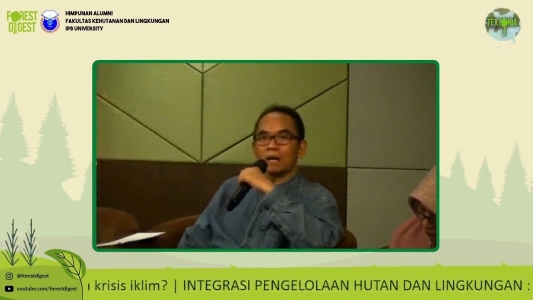Prof Hariadi Kartodihardjo: Integration of Forest Management Must be Based on Empirical Evidence, The Policy then, not the other way around

Forests are Indonesia's hope for maintaining the stability of environmental functions and controlling the climate crisis. More than 120 million hectares of forest are used as the primary source of carbon stocks.
Prof Hariadi Kartodihardjo, Professor of Forestry Policy at IPB University, explained that forest management requires integration with cross-disciplinary knowledge. Forest conservation and rehabilitation efforts will not be able to work if only relying on tree planting. According to him, policies related to the integration of forest management must go through empirical evidence first.
“Integration of forest management is very important because it is not enough to pay attention to only certain aspects. Forest management does not only involve forest areas but also social, economic, and political aspects," explained the lecturer at the Faculty of Forestry and Environment (Fahutan) IPB University.
"Whether we want it or not, different perspectives require a certain kitchen to ensure how the portion of the mixture is right," he said in a Forest Digest discussion entitled 'Integration of Forest and Environment Management: Can it answer the challenge of the climate crisis?' at the IPB International Convention Center (IICC), Bogor, recently.
According to Prof Hariadi, forest management is not specific because it has a multiplier effect. Impact control and its resources require cooperation from various parties.
"It is not easy to implement, because the solutions, mindset, and conditions of our government have their respective roles. In reality on the ground, we have to look at it as a whole (comprehensively)," he continued.
He added, every forest area in Indonesia and its existence in each region has important and special characteristics so that it cannot be generalized. Each forest has a different situation, so the forest development plan must be developed according to the needs of the area.
“We have to be able to see empirical evidence first, then followed by policy formulation. It is better if the government needs to look at the characteristics of the forest, socio-cultural aspects, and politics relevant to each region," he said.
He explained that there is a general formula in the context of forest management integration, namely situation, structure, behavior, and performance (SSBP). The formulation of the forest management policy is based on SSBP analysis. Policies integration needs to be based on the situation of each forest area and the form of integration will adapt to unchanging natural conditions. (MW/Rz) (IAAS/HAP)



